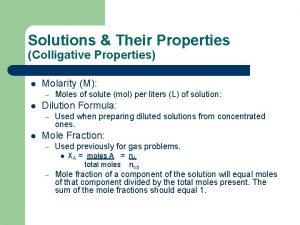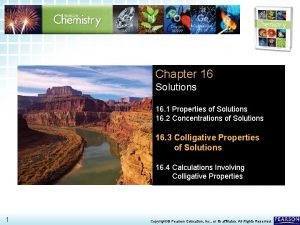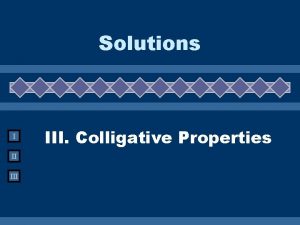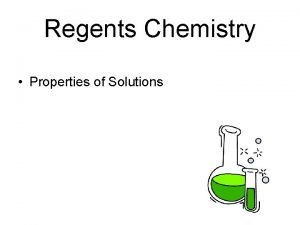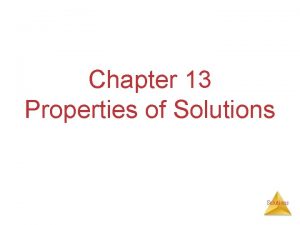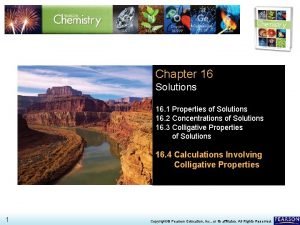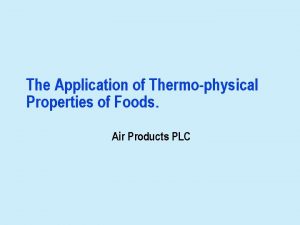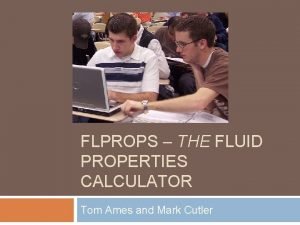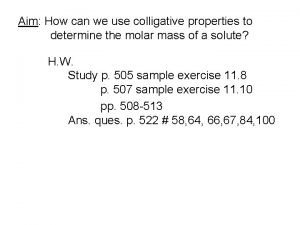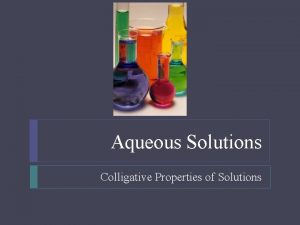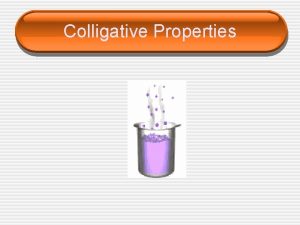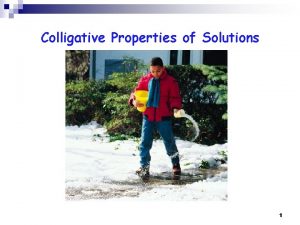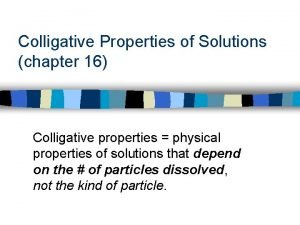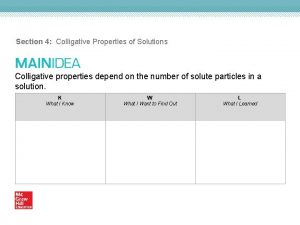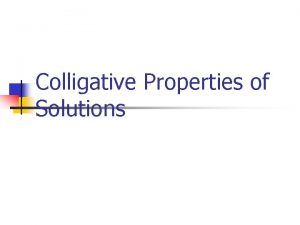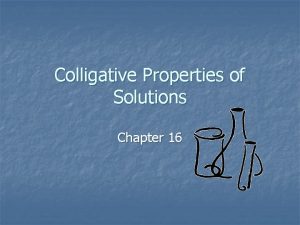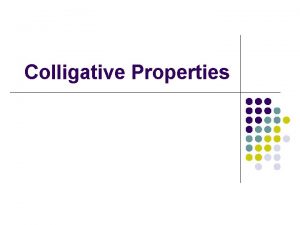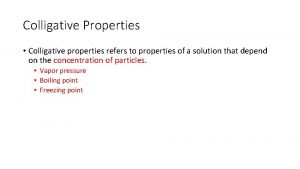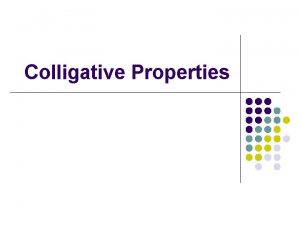Solutions Their Properties Colligative Properties l Molarity M



















- Slides: 19

Solutions & Their Properties (Colligative Properties) l Molarity (M): – l Dilution Formula: – l Moles of solute (mol) per liters (L) of solution: Used when preparing diluted solutions from concentrated ones. Mole Fraction: – Used previously for gas problems. l – XA = moles A = n. A total moles ntot Mole fraction of a component of the solution will equal moles of that component divided by the total moles present. The sum of the mole fractions should equal 1.

Mass Percent (%) l l Mass percent is determined by the mass of the solute divided by the total mass of the solution, then multiplied by 100. Example: If a solution is prepared by dissolving 24 g of Na. Cl in 152 g of water, calculate the percent, by mass, of Na. Cl. – – Sometimes when the amounts are so small (trace amounts) we use parts per million (ppm) or parts per billion (ppb). For example, if we have 5 x 10 -8 grams of arsenic in 1. 00 grams of water that will be equivalent to 0. 05 ppm of Arsenic in water. For ppm we multiply by a factor of 106 and for ppb we multiply by a factor of 109.

Molality (m) l Molality is determined my moles of solute per kilograms of solvent. m = moles of solute kilograms of solvent

Conversions between concentration units: Example 1 l The electrolyte in automobile lead storage batteries is a 3. 75 M sulfuric acid solution that has a density of 1. 23 g/m. L. Calculate the mass percent and molality of the sulfuric acid. – Ans: 29. 9% H 2 SO 4 and 4. 35 m H 2 SO 4

Principles of Solubility l l Like dissolves like…. . meaning polar generally dissolves polar and nonpolar dissolves nonpolar. Effects of Temperature: – – l Solids – the higher the temperature, generally the higher the solubility. An increase in temperature always shifts the position of an equilibrium to favor an endothermic process, which means H >0. Gases – become less soluble as the temperature rises. Why? Effects of Pressure: – – Pressure only has an effect on gas-liquid solutions. Do pressure and the solubility of a gas have an inverse or direct relationship? Henry’s Law: Cg = k. Pg Cg = concentration of the gas (M) k = constant for the gas-liquid system – this will vary (M/atm) Pg = Pressure of the gas (atm)

Henry’s Law: Example 2 l A certain soft drink is bottled so that a bottle at 25 o. C contains CO 2 gas at a pressure of 5. 0 atm over the liquid. Assuming that the partial pressure of CO 2 in the atmosphere is 4. 0 x 10 -4 atm, calculate the quilibrium concentrations of CO 2 in the soda both before and after the bottle is opened. The Henry’s law constant for CO 2 in aqueous solution is 3. 1 x 10 -2 mol/L atm at 25 o. C. – Ans: before 0. 16 M, after 0. 000012 M

Colligative Properties of Nonelectrolytes l l Properties of solutions differ from the properties of the pure solvent. The solution properties depend more so on the concentration of the solute particles. – – – Vapor Pressure Lowering Boiling Point Elevation Freezing Point Lowering

Vapor Pressure Lowering Concentrated solutions evaporate more slowly than pure water, meaning they have a lower vapor pressure. l With an increase in concentration of solute the vapor pressure lowers – this is Raoult’s Law: ΔP = X 2 P 10 or P = X 1 P 10 ΔP = change in pressure (P 10 - P 1) in mm. Hg X 2 = mole fraction of solute P 10 = vapor pressure of the pure solvent in mm. Hg P = vapor pressure of the solution X 1 = mole fraction of solvent

Vapor Pressure Lowering: Example 3 l Calculate the expected vapor pressure at 25 o. C for a solution prepared by dissolving 158. 0 g of common table sugar (sucrose, M = 342. 3 g/mol) in 643. 5 cm 3 of water. At 25 o. C, the density of water is 0. 9971 g/cm 3 and the vapor pressure is 23. 76 torr. – ans: 23. 46 torr

Boling Point Elevation A solution does not begin to boil until the temperature exceeds that of the solvent. The greater the concentration of the solute the higher the temperature needed to boil the solution: ΔTb = kb x m m = molality (m) kb = Molal Boiling Point Constant (0 C/m) ΔTb = change in temp at which solution boils (Tb - Tb 0) -Tb = the temp at which the solution boils -Tb 0 = the temp at which the pure solvent boils

Boiling Point Elevation: Example 4 l A solution was prepared by dissolving 18. 00 g of glucose in 150. 0 g of water. The resulting solution was found to have a boiling point of 100. 34 o. C. The molal boiling-point elevation constant for water is 0. 51 o. C kg/mol. Calculate the molar mass of glucose. Glucose is a molecular solid that is present in individual molecules in solution. – ans: 180. 0 g/mol

Freezing Point Depression When a solution is cooled it does not begin to freeze until a temperature below the freezing point of the solvent is reached. The greater the concentration the lower the temperature required for freezing: ΔTf = kf x m l l l m = molality kf = Molal freezing point constant ΔTf = change in temp at which solution freezes (Tf 0 - Tf) – – Tf = the temp at which the solution freezes Tf 0 = the temp at which the pure solvent freezes

Osmotic Pressure l l Osmosis is a process taking place through a membrane permeable to only the solvent is called osmosis. Water moves from a region where its vapor pressure or mole fraction is high to one in which it’s vapor pressure or mole fraction is low. Osmotic pressure is directly proportional to the molarity (M) – this is why it is a colligative property: π = n. RT = MRT V


Osmotic Pressure: Example 5 l To determine the molar mass of a certain protein, 1. 00 x 10 -3 g of it was dissolved in enough water to make 1. 00 m. L of solution. The osmotic pressure of this solution was found to be 1. 12 torr at 25 o. C. Calculate the molar mass of the protein. – ans: 1. 66 x 104 g/mol

FRQ #1 l An unknown compound contains only the three elements C, H, and O. A pure sample of the compound is analyzed and found to be 65. 60 percent C and 9. 44 percent H by mass. (a) Determine the empirical formula of the compound. (b) A solution of 1. 570 grams of the compound in 16. 08 grams of camphor is observed to freeze at a temperature 15. 2 Celsius degrees below the normal freezing point of pure camphor. Determine the molar mass and apparent molecular formula of the compound. (The molal freezing-point depression constant, Kf, for camphor is 40. 0 kg • K • mol-1. ) (c) When 1. 570 grams of the compound is vaporized at 300°C and 1. 00 atmosphere, the gas occupies a volume of 577 milliliters. What is the molar mass of the compound based on this result? (d) Briefly describe what occurs in solution that accounts for the difference between the results obtained in parts (b) and (c).

FRQ #2 l Concentrated sulfuric acid (18. 4 -molar H 2 SO 4) has a density of 1. 84 grams per milliliter. After dilution with water to 5. 20 -molar, the solution has a density of 1. 38 grams per milliliter and can be used as an electrolyte in lead storage batteries for automobiles. (a) Calculate the volume of concentrated acid required to prepare 1. 00 liter of 5. 20 -molar H 2 SO 4. (b) Determine the mass percent of H 2 SO 4 in the original concentrated solution. (c) Calculate the volume of 5. 20 -molar H 2 SO 4 that can be completely neutralized with 10. 5 grams of sodium bicarbonate, Na. HCO 3. (d) What is the molality of the 5. 20 -molar H 2 SO 4?

FRQ #3 l l Elemental analysis of an unknown pure substance indicated that the percent composition by mass is as follows: carbon 49. 02%, hydrogen 2. 743%, chlorine 48. 23%. A solution that is prepared by dissolving 3. 150 grams of the substance in 25. 00 grams of benzene, C 6 H 6, has a freezing point of 1. 12°C. (The normal freezing point of benzene is 5. 50°C and the molal freezing-point depression constant, Kf, for benzene is 5. 12°C/molal. ) (a) Determine the empirical formula of the unknown substance. (b) Using the data gathered from the freezing-point depression method, calculate the molar mass of the unknown substance. (c) Calculate the mole fraction of benzene in the solution described above. (d) The vapor pressure of pure benzene at 35°C is 150. millimeters of Hg. Calculate the vapor pressure of benzene over the solution described above at 35°C.

Equations Practice (a) A solution of sodium hydroxide is added to a solution of lead(II) nitrate. (i) Balanced equation: (ii) If 1. 0 L volumes of 1. 0 M solutions of sodium hydroxide and lead(II) nitrate are mixed together, how many moles of product(s) will be produced? Assume the reaction goes to completion. (b) Excess nitric acid is added to solid calcium carbonate. (i) Balanced equation: (ii) Briefly explain why statues made of marble (calcium carbonate) displayed outdoors in urban areas are deteriorating. (c) A solution containing silver(I) ion (an oxidizing agent) is mixed with a solution containing iron(II) ion (a reducing agent). (i) Balanced equation: (ii) If the contents of the reaction mixture described above are filtered, what substance(s), if any, would remain on the filter paper.
 Is molarity a colligative property
Is molarity a colligative property Ions in aqueous solutions and colligative properties
Ions in aqueous solutions and colligative properties Pure solvent
Pure solvent Pourcentage massique
Pourcentage massique Dot
Dot Colligative property definition
Colligative property definition Colligative properties definition
Colligative properties definition Colligative properties regents questions
Colligative properties regents questions Colligative properties of milk
Colligative properties of milk Colligative properties of solution examples
Colligative properties of solution examples Colligative properties worksheet
Colligative properties worksheet Van’t hoff factor
Van’t hoff factor Pure solvent
Pure solvent Colligative properties depend on the _____.
Colligative properties depend on the _____. Colligative properties depend on
Colligative properties depend on Colligative properties sample problems
Colligative properties sample problems Applications of colligative properties in foods
Applications of colligative properties in foods Fluid property calculator
Fluid property calculator Calculating molar mass using colligative properties
Calculating molar mass using colligative properties Colligative properties notes
Colligative properties notes
